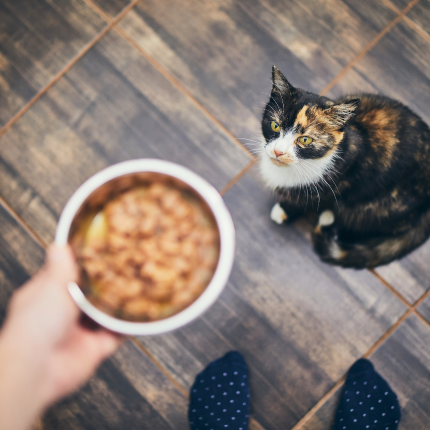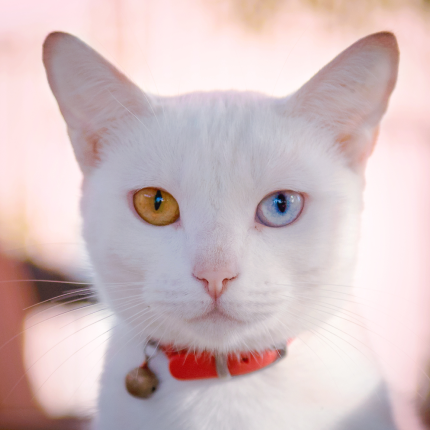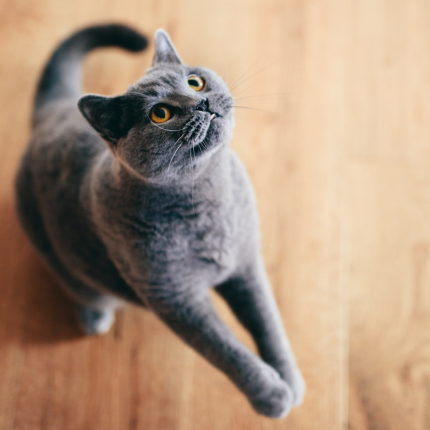What Is Your Cat’s Body Language During Mealtime

Feeding time for your feline friend can unveil a variety of behaviors, especially in households with multiple cats. Understanding your cat’s body language during mealtime can offer valuable insights into her needs and preferences. Here’s a breakdown to help you interpret her cues:
1. Sitting by Empty Food Bowl:
Your cat’s anticipation of mealtime may lead her to sit by her empty food bowl, signaling her familiarity with routine and her innate instinct to ensure a steady food supply. This behavior can also stem from past experiences, particularly if she was previously accustomed to hunting for meals. To manage this behavior, maintain a consistent feeding schedule and provide environmental enrichment to keep her engaged.
2. Rubbing Against Your Legs:
Flank rubbing as you head to the kitchen signifies your cat’s excitement and affection, acknowledging your role as a cherished member of her family.
3. Eating Only When You’re Present:
Your cat’s reluctance to eat without your presence may indicate a need for additional security and comfort. Ensure a peaceful mealtime environment free from disturbances and consider staying nearby if needed.
4. Paw Scooping:
Paw scooping food out of the bowl may suggest discomfort caused by the bowl’s size or shape, hindering her ability to eat comfortably. Opt for low and wide bowls to prevent whisker discomfort and ensure unobstructed visibility.
5. Trying to “Bury” Food:
Your cat’s attempt to “bury” food is rooted in her survival instinct to conceal scent in outdoor settings. This behavior does not signify dislike for the food but rather a response to perceived threats.
6. Looking Around While Eating:
Nervous behavior while eating, such as frequent glancing around, may indicate discomfort or anxiety in her surroundings. Adjust the food bowl placement and minimize distractions to create a calm eating environment.
7. Resource Guarding Behavior:
Aggressive displays during mealtime may stem from a cat’s instinct to protect her food resource. Provide separate feeding stations to alleviate tension and ensure each cat feels secure.
8. Nosing into Another Cat’s Food Bowl:
Stealing food from companion cats can indicate concerns over food scarcity or a display of dominance. Ensure ample space between feeding stations and monitor mealtime to prevent conflicts.
9. Eating Too Fast:
Rapid eating may lead to digestive issues and vomiting. Consider offering multiple small meals throughout the day and use slow-feeder bowls to regulate her eating pace.
10. Tilting Head and Eating on One Side of the Mouth:
This behavior may signal underlying dental issues or mouth pain, necessitating veterinary attention.
By observing your cat’s body language during mealtime, you can better cater to her needs and ensure a positive feeding experience.

Featured Articles

The Odd-Eyed Cat (AKA Heterochromia)
Cats are already beautiful and fascinating creatures, but people are bound to take notice when they have something as captivating as two different colored eyes. Odd-eyed cats always have one blue eye paired with either a green, yellow, or brown eye. This form of heterochromia occurs in other animals, including…

Greebles and Cats: The Origin and the Meaning
You may have seen an internet sensation concerning cats labeled “greebles.” Feel out of the loop? We’re here to help you. In 2019, Reddit user /user/literallyatree commented on a Reddit post about a cat that looks like it’s trying to slap a ghost. This user commented: “My family calls things…

Why Do Cats Roll Over Into Their Backs But Not Let You Touch Their Bellies?
It’s common knowledge dogs love to have their tummies rubbed when they freely lay down before you and roll onto their backs. But, if you’re also familiar with cats, you know that when they roll onto their backs with their bellies exposed, rubbing the belly will most likely result in…
